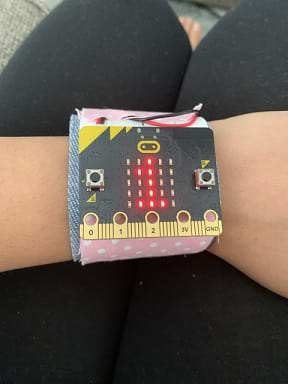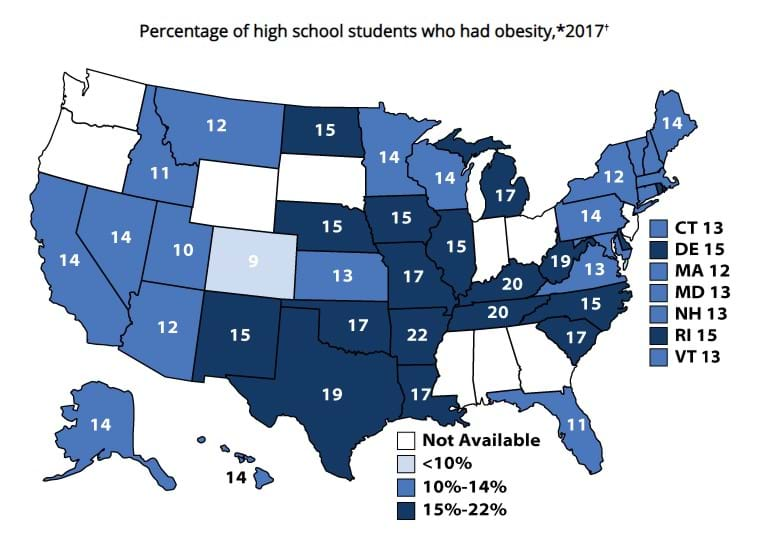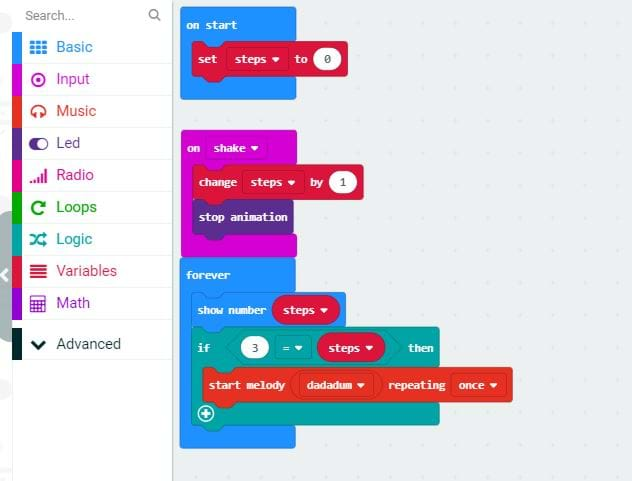Quick Look
Grade Level: Middle school
Time Required: 3 hours (wild guess!)
(three 60-minute class periods)
Subject Areas: Computer Science, Life Science, Problem Solving, Science and Technology

Maker Challenge Recap
Allow students to put on their biomedical and computer engineer hats to help solve a real-world problem: obesity within the middle school community. Students use the engineering design process to design, create, and test a pedometer that keeps track of the number of steps a person takes. Students also explore the relationship between wearable technologies and overarching health conditions, specifically obesity, through various health-related research papers, online research and short documentaries. Students use a micro:bit processer and Microsoft Make Code to build their prototype. This maker challenge utilizes the engineering design process as it exposes students to basic coding, micro:bit processor applications and how programming and engineering can be used to solve health problems. Finally, students test the accuracy of their pedometer by conducting some simple self-experimentation to compare their step count in a day.
Maker Materials & Supplies
Note: fabric and adhesives are suggestions, but by no means represent an exhaustive list; feel free to get creative!
- micro:bit Go kit (cable, battery pack and 2 AAA batteries included), per group available online
- computer running Windows, OS X, or Linux
- Microsoft MakeCode Online Access
- clothing fabric, 30 cm x 10 cm, per group (old t-shirts work well)
- denim fabric, 30 cm x 10 cm, per group
- Velcro with adhesive backing, 5 cm x 5 cm per group
- double-sided tape, 22 cm x 5 cm, per group
- ruler and pen
- scissors
- smartphone or device with access to a step counter app; examples: Google Fit, Leap Fitness Step Counter and Pedometer & MyFitnessPal (Android)/ Pacer Pedometer & Step Tracker, Stepz & Accupedo (Apple), FitBit
- KLEWS Chart
- Engineering Design Process Worksheet
Worksheets and Attachments
Visit [www.teachengineering.org/makerchallenges/view/rice3-2481-pedometer-wearable-technology-design-challenge] to print or download.Subscribe
Get the inside scoop on all things TeachEngineering such as new site features, curriculum updates, video releases, and more by signing up for our newsletter!Kickoff
Did you know that recent data shows that nearly 1 in 5 school-age children and young people (6-19 years) in the United States suffers from obesity? (Show students Figure 1, the “Percentage of high school students who had obesity in the United States in *2017.”)

Why do you think all these young people are struggling with obesity? Why is being obese considered a health issue? What happens if children are obese? (Listen to student responses.)
Possible responses: (Young people are struggling with obesity because they do not work out, they eat unhealthy food, they are spending too much time on the computer, school lunches are making them obese, etc. Obesity can lead to other health issues such as diabetes, high blood pressure, thinning of arteries, fatty deposition of arteries, cardiovascular in later life, stun children’s’ growth, etc.)
How can we as engineers and programmers help solve this problem using technology? (Listen to student responses.)
Possible responses: (Create games that allow children to add movement to their day, create devices or apps that allows children to monitor their health and diet such as a pedometer, raise awareness about obesity through an educational curriculum, free healthy lunches, etc.)
Your task: help students like you overcome obesity by designing and testing your very own pedometer using a micro:bit processor, Make Code, and some art and craft supplies. A micro:bit can be transformed into a pedometer using Make Code, your goal will be to program your micro:bit to display a number that changes as the individual moves and the micro:bit shakes.
Many factors must be taken into consideration when designing your pedometer, especially due to its nature as wearable technology. Keep your clients in mind while designing the physical features of your pedometer.
After creating your first prototype, you might ask the question: How can we improve the micro:bit to be more efficient as a pedometer? Would I be able to use another microcontroller instead of micro:bit? You and your fellow engineers need to figure this out on your own. Remember to test your prototype just as engineers would do—by using your pedometer for a whole day to check your own step count.
Resources
- Refer to the Engineering Design Process hub on TeachEngineering to guide your students through the challenge.
- Childhood obesity: A comparison of health habits of middle-school students from two communities, US National Library of Medicine
- Using pedometers to increase physical activity in overweight and obese women: a pilot study, US National Library of Medicine
- Adolescent Obesity Prevalence: Trends Over Time (2003-2017), Centers for Disease Control and Prevention
- Thinking on their feet: In-class exercise helps fight childhood obesity while kids learn, Michigan News, University of Michigan
- Students should learn how to perform basic coding challenges with micro:bit in Make Code.
- It may help students with their prototype, if you provide them with this watch tutorial.
Maker Time
- Ask: Identify the Needs and Constraints (10 minutes):
- Hand the students Engineering Design Process Worksheet. Inform the students, this process is used by engineers to solve problems. Assist the students with Step 1: Ask the students: What is the problem that we are trying to solve? Who is affected by this problem? Why is this problem important and relevant? Make sure you probe students further that do not include all the parameters of the problem. Have students record their answers on the Engineering Design Process Worksheet.
- Possible student responses: (The problem is obesity. It affects children and even adults. This problem is important because if we do not find a solution- people will die or suffer from poor quality of life.)
- Research/Independent Brainstorming (30 minutes):
- Have students reviewed the research either one of these research papers: “Childhood obesity: A comparison of health habits of middle-school students from two communities“ or “Using pedometers to increase physical activity in overweight and obese women: a pilot study.” See Resources.
- Imagine Possible Solutions: Team Brainstorming (30 minutes):
- In groups, discuss possible solutions to the problem of obesity in middle school students. Record ideas on an anchor chart.
- Evidence of student research: [KLEWS Charts & anchor chart]
- Give students time to unpack their micro:bits and explore the Make Code website. Have them pick a project to work on independently.
- Design (40 minutes):
- Instruct students to work on creating code that will be used by their pedometers; allow students more or less time, depending on experience and group sizes.
- Create a maker space where all the project materials are available, including different choices of fabric, adhesive materials and measuring tools. Encourage students to experiment with different fabrics and adhesive material to create a watch that will hold their pedometer.
- Evaluate (in class 10 minutes):
- Have students test their pedometer for a whole day. Once they return, allow them to evaluate their product and think of further innovations. If possible, have students compare their collected data with a step counter app.
- Re-design (10 minutes):
- Have students think about why their data is different from the app data. What worked well in their pedometers? Ask them to think about what could be done to improve their pedometer. Emphasis that evaluating and re-designing doesn’t mean “starting over”-rather it means “further improvement” or iteration.
- Possible responses: (Use a different microcontroller. Change the program so slight movement is also detected as a step. Create an ankle pedometer instead of a watch. Add program that plays a sound when 1,000 steps are reached to encourage the user.)
- Communicate Ideas (40 minutes):
- Students present their designs and their programs, and compare data using PowerPoint or Google Sheets—this includes screen shots of their program as well. Encourage the audience to ask probing questions.
- Sample probing questions:
- What was the hardest or simplest part of your project, and why?
- How did you use the engineering design process in your project? Why was this process useful to your project?
- What the input/output of your watch? What does the ‘processing’ of your watch?
- How could your pedometer solving the problem of obesity?
- If you could request for additional materials, what would you like and how would you use these materials?

Wrap Up
As a class, have students share, compare and reflect on how to improve their products design and efficiency:
- If you could redesign or reprogram your pedometer, how would you change it? Why would you make these changes?
- What discrepancies did you notice as you used your pedometer? How would you fix these discrepancies in your next prototype?
- Could you think of another possible solution using technology to solve the problem of childhood obesity?
Tips
- Students will need time to explore the programming environment if this is their first programming experience. Time is built-in for pure exploration.
- For a more challenging project, do not provide students with the Make Code tutorial.
Copyright
© 2019 by Regents of the University of Colorado; original © 2019 Rice UniversityContributors
Azka BukhariSupporting Program
Precise Advanced Technology and Health Systems for Underserved Populations (PATHS-UP) Research Experience for Teachers (NSF EEC-1648451), Rice Office of STEM Engagement and Department of Electrical and Computer Engineering, Rice UniversityAcknowledgements
This activity was developed as part of the Research Experience for Teachers through the Office of STEM Engagement and the Department of Electrical and Computer Engineering at Rice University supported by the National Science Foundation under grant number NSF EEC 1648451. Any opinions, findings and conclusions or recommendations expressed in this material are those of the authors and do not necessarily reflect the views of the National Science Foundation or Rice University.
Special acknowledgements to Christina Crawford, Allen Antoine with the Rice University Office of STEM Engagement, and Yongyi Zhao with the Scalable Health Labs at Rice University for his help and support in developing this activity.
Last modified: August 8, 2025





User Comments & Tips